Home / Meet the (Most Important) Functional Groups
Alkanes and Nomenclature
Meet the (Most Important) Functional Groups
Last updated: June 11th, 2025 |
All About Functional Groups
- Functional groups are specific groupings of atoms within molecules that have their own characteristic properties, regardless of the other atoms present in a molecule.
- Common examples of functional groups are alcohols, alkenes, alkynes, amines, carboxylic acids, aldehydes, ketones, esters, and ethers, among others.
- In a typical sophomore organic chemistry course, there are about 15 key functional groups, with another group of 10 or so that make consistent appearances. You’ll meet others, too – this is just a selection of the most common.
Table of Contents
- Functional Groups
- Alkanes, Alkenes, Alkynes, and Aromatic Rings
- Alcohols, Ethers, Amines, Thiols, Alkyl Halides
- Aldehydes, Ketones, Carboxylic Acids, and Esters.
- Amides, Acid Halides, Anhydrides, Nitriles
- Miscellaneous: Epoxides, Thioethers, Nitro, Imine, Azide
- Notes
- Quiz Yourself!
- (Advanced) References and Further Reading
1. Functional Groups
A functional group is what we call specific groupings of certain atoms within molecules that have their own characteristic properties.
Here are some of the most commonly encountered functional groups. Note that “R” is a placeholder for a generic carbon substituent.
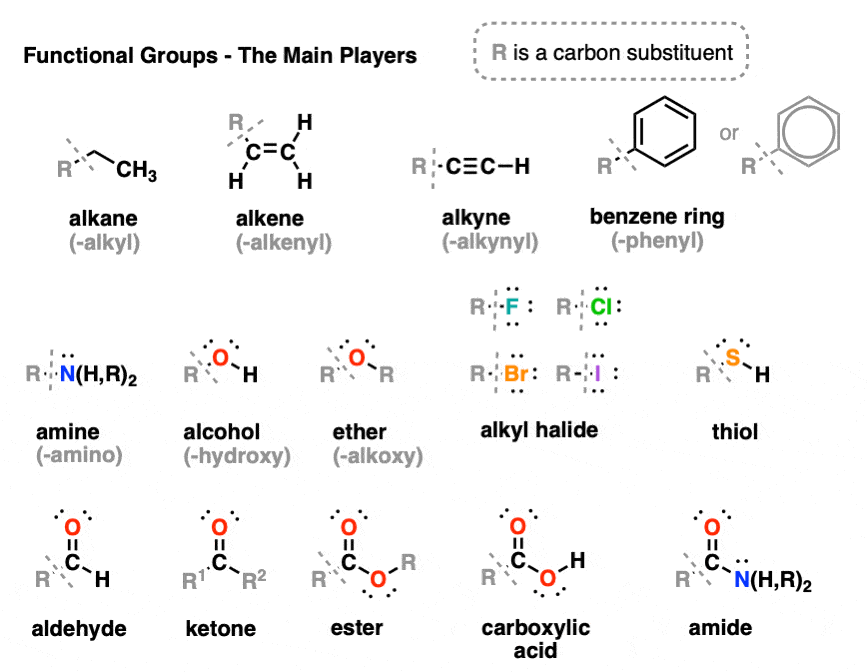
A second group of slightly less commonly encountered functional groups are here. This is by no means an exhaustive list, but it’s at least a good start.
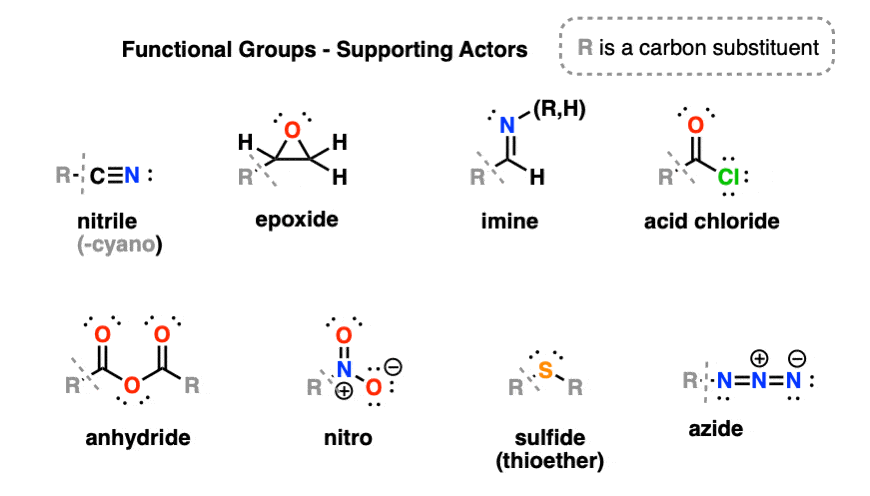
In the beginning of the course, being presented with a list of 20-25 functional groups to remember might seem like a lot. And it probably is!
The good news is that you’ve already learned a lot of functional group names without trying too hard.
Do these names sound familiar?
Propane. Tylenol. Ibuprophen. Testosterone. Dopamine.
Learning functional groups will be a matter of connecting those names to general structures.
Another good way to get to know functional groups is to think about the relative electronegativities of the elements in each group. That will help you understand their properties and help you think about how they behave in chemical reactions.
2. Alkanes, Alkenes, Alkynes, and Aromatic Rings
The hydrocarbon functional groups are very non-polar and tend to be extremely weak acids.
In hydrocarbons, the only types of intermolecular interactions are London dispersion forces and their boiling points tend to be quite low, relative to molecules containing more polar functional groups. (See article: 3 Trends That Affect Boiling Points)
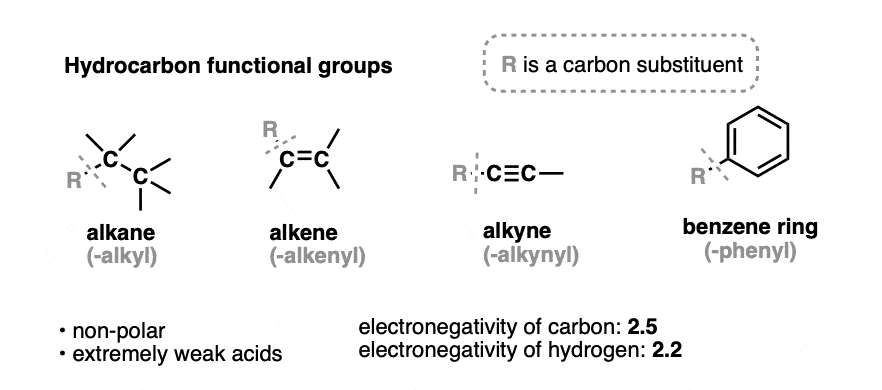
Alkanes are hydrocarbons containing no multiple bonds. Alkane substituents are called alkyl groups, which refers to alkane groups lacking a C-H bond such as methyl, ethyl, or propyl.
- Common examples of alkanes are methane, ethane, propane, butane, and octane.
- The C-H bond is highly covalent and alkanes are very non-polar. They do not mix with water (not “miscible“, in other words)
- Alkyl carbons are sp3 hybridized and have tetrahedral geometry about the carbon.
- You can often think of alkyl groups as the “spectator” functional groups of organic chemistry, abbreviated as R-. With the exceptions of free-radical substitution and, of course, combustion, alkanes don’t undergo a huge number of different reactions. They tend to provide the backbone of most organic molecules.
Alkenes are hydrocarbons with one or more carbon-carbon double bonds.
- Common examples are ethene, propene, and butene.
- Alkene substituents are called alkenyl groups; vinyl is often used to refer to -CH=CH2 .
- Alkenyl carbons are sp2 hybridized, with a trigonal planar geometry.
Alkynes contain a carbon-carbon triple bond.
- Ethyne (acetylene) is the simplest alkyne; alkynes are sometimes called acetylenes.
- Alkyne substituents are called alkynyl groups.
- Terminal alkynes have a C-H. Internal alkynes have C-C bonds at each end.
- Alkynyl carbons are sp hybridized with a linear geometry.
Benzene rings are six-membered rings containing 3 double bonds. Benzene rings are common in nature due to a property called aromaticity (nothing to do with its smell, see article) that make them unusually stable. Can also be drawn as a hexagon with a circle.
- Methylbenzene (toluene) is responsible for the smell of model airplane glue.
- Benzene substituents C6H5– are called phenyl groups.
- The carbons in benzene are sp2 hybridized with trigonal planar geometry.
Draw examples of alkanes, alkenes, alkynes, and aromatic rings.
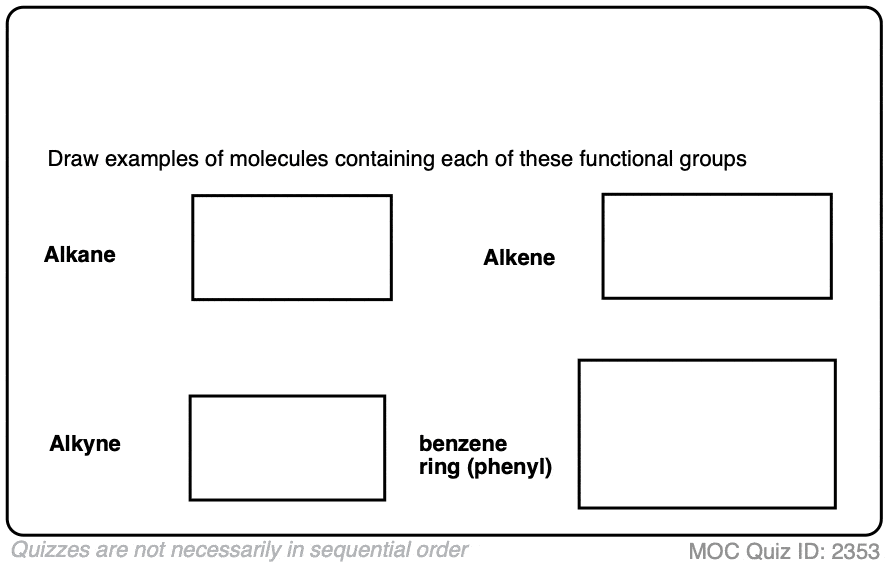 Click to Flip
Click to Flip
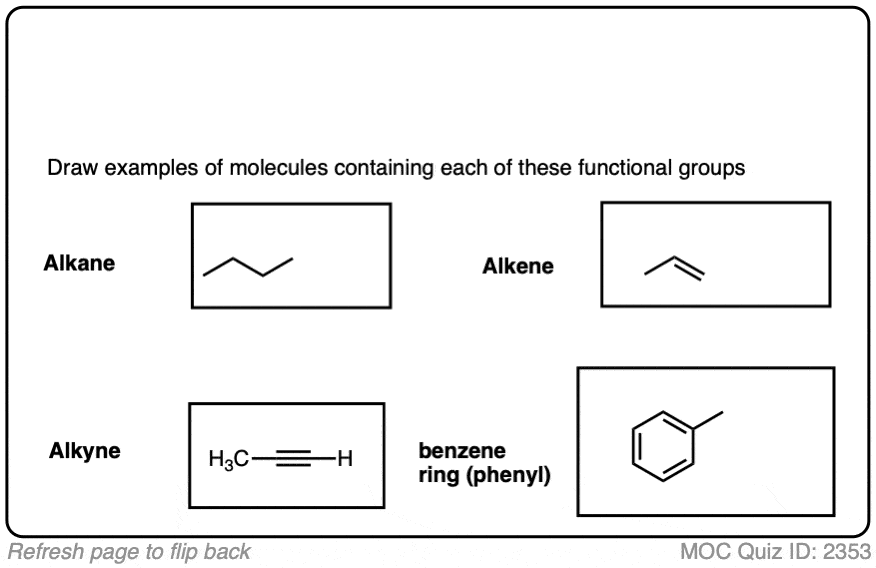
The following molecules lack substituents. Draw them in.
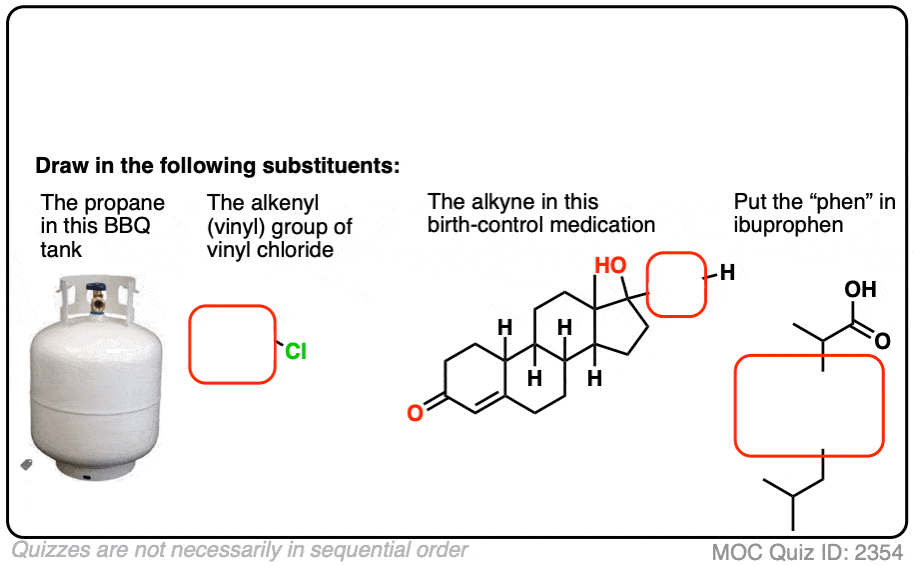 Click to Flip
Click to Flip
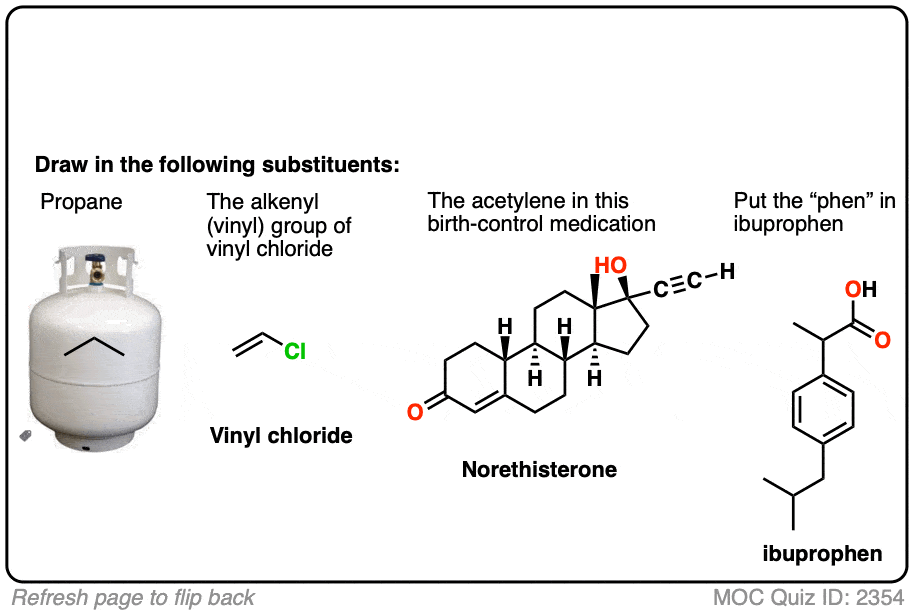
Worchestershire
3. Alcohols, Ethers, Amines, Thiols, Alkyl Halides
These functional groups are considerably more polar due to the greater difference in electronegativities between the bonding atoms.
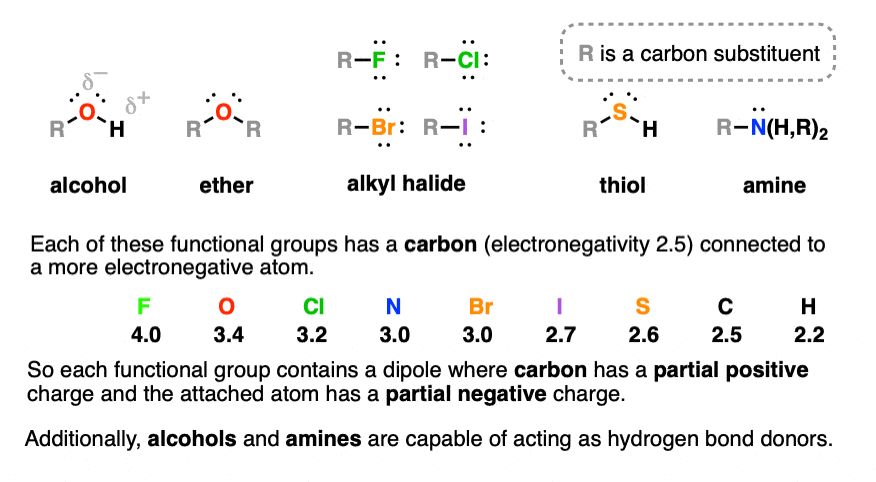
Stronger intermolecular forces are present in these functional groups due to the dipole-dipole interactions. Additionally, alcohols and amines are capable of hydrogen bonding, which further increase boiling points.
Alcohols R-OH contain carbon bonded to the hydroxyl group -OH.
- Common examples include methanol, methanol, isopropanol.
- The O-H bond is highly polarized and participates in hydrogen bonding.
- Hydroxyl groups also increase water solubility.
- Alcohols are weak acids and can also act as Lewis bases.
- Hydroxyl groups bonded to C=O are considered to be carboxylic acids, a separate functional group (see below)
Ethers R-O-R are oxygen atoms flanked by two bonds to carbon.
- Diethyl ether, tetrahydrofuran, and dioxane are ethers that are commonly used as lab solvents.
- Ethers cannot serve as hydrogen-bond donors, so their boiling points are lower than those of alcohols of equivalent molecular weight, but higher than those of hydrocarbons due to greater dipole-dipole forces.
Alkyl halides have functional group R-F, R-Cl, R-Br, R-I where R is an alkyl group.
- Bromobutane, methyl bromide, and chloroform are all examples of alkyl halides.
- Dipole-dipole interactions lead to higher boiling points than those found in alkanes.
- If R is alkene, they are alkenyl halides.
- Very important functional groups for substitution and elimination reactions.
Amines contain the functional group -NH2, -NHR, or NR2 where R is a hydrocarbon.
- Morphine, codeine, and cocaine are just three of many prominent molecules that contain amines.
- Amine substituents are known as amino groups.
- Amines with N-H bonds are capable of hydrogen bonding, which leads to higher boiling points and water solubility.
- The lone pair on the nitrogen can act as a base.
Thiols (mercaptans) R-SH are the sulfur-containing cousins of alcohols.
- The sulfur atom is not nearly as electronegative as oxygen, so the S-H bond is considerably less polarized.
- Thiols can act as weak acids; stronger acids than alcohols.
- Thiols are most notorious for their strong stench; ethanethiol is added to natural gas to give it its characteristic smell.
Draw examples of each of these functional groups.
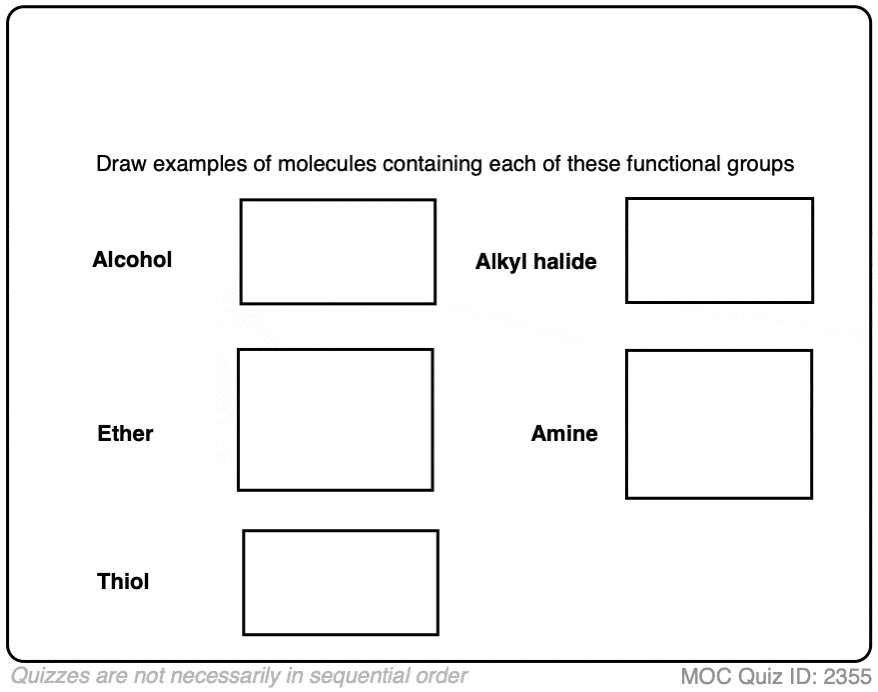 Click to Flip
Click to Flip
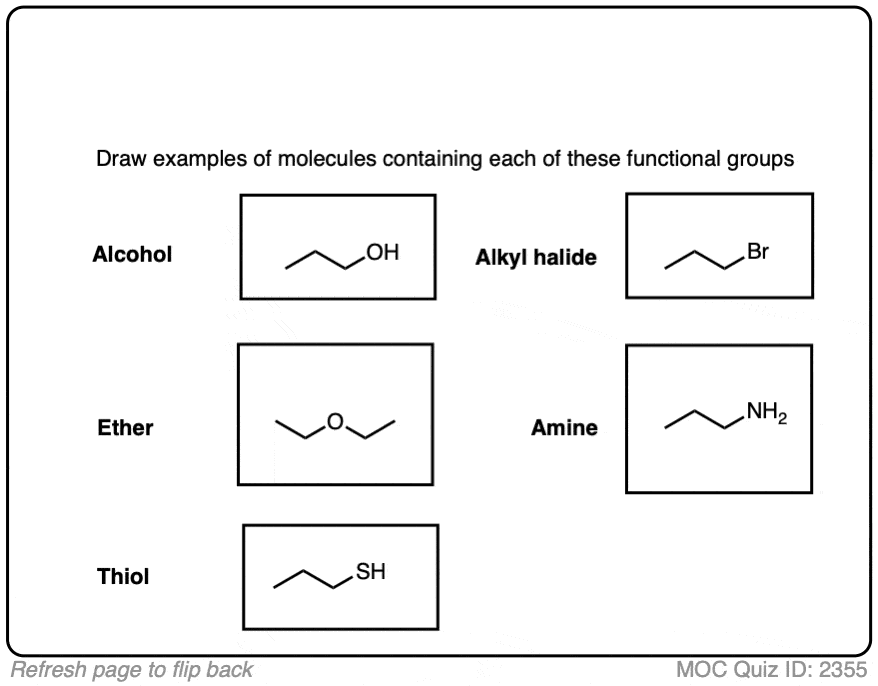
Draw in the functional groups of these famous molecules.
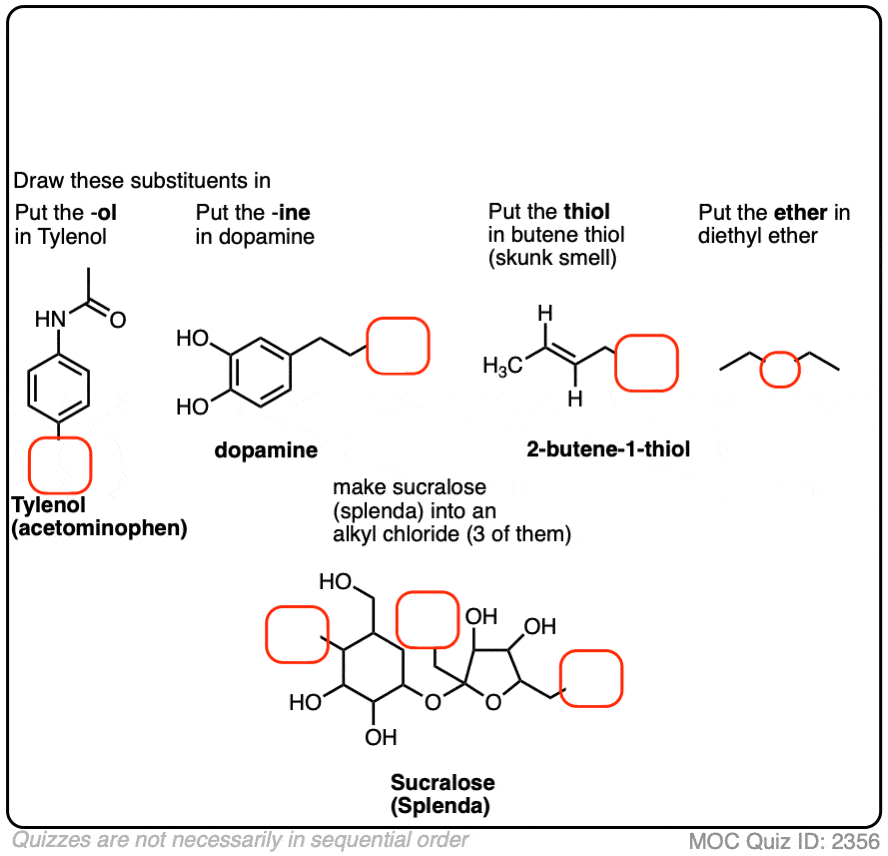 Click to Flip
Click to Flip
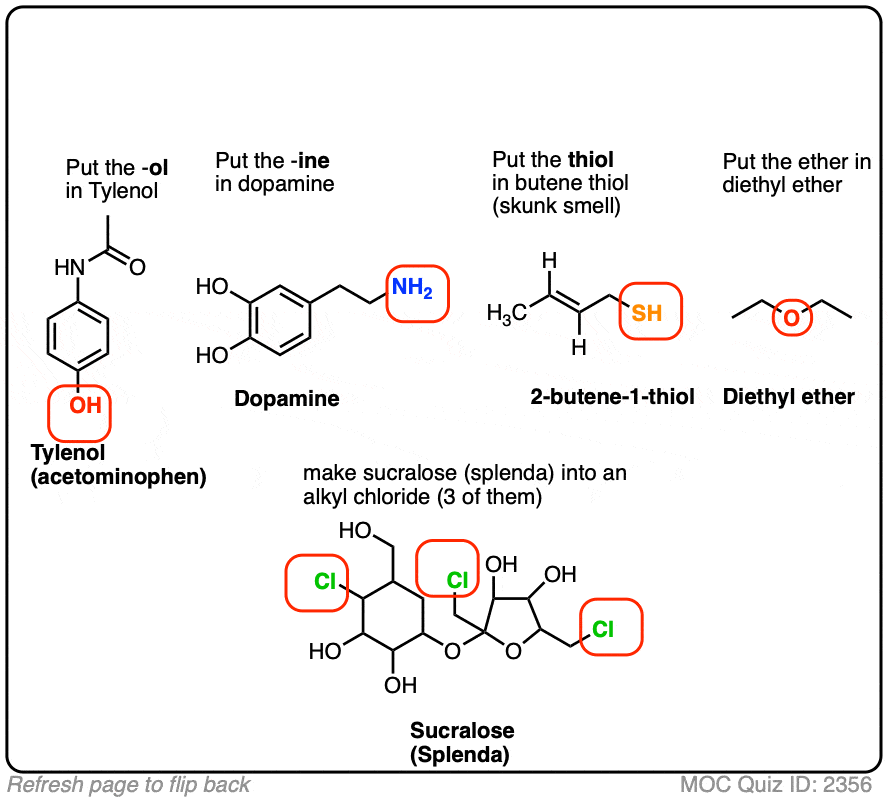
4. Aldehydes, Ketones, Carboxylic Acids, Esters
The C=O group is referred to as the carbonyl group. The C=O bond is strongly polarized towards oxygen and the carbon bears a partial positive charge.
Carbonyls are found in aldehydes, ketones, esters, and carboxylic acids.
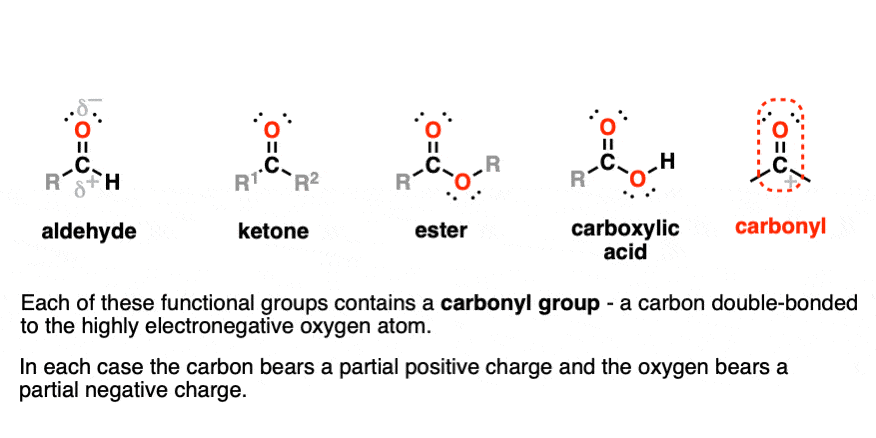
Aldehydes RCHO have C=O bonded to carbon and to C-H
- Formaldehyde, acetaldehyde, and benzaldehyde are common examples.
- They have polar covalent bonding but are not hydrogen bond donors
Ketones RC(O)R have C=O bonded to two carbons.
- Acetone (2-propanone) is nail polish remover.
Carboxylic Acids RCOOH have a carbonyl bonded to -OH. They are distinct functional groups from alcohols.
- Acetic acid (vinegar) and formic acid are the simplest carboxylic acids. Other short-chain acids like butanoic and pentanoic acids are notorious for their locker-room smells (or worse).
- The hydroxyl group participates in hydrogen bonding and carboxylic acids have higher boiling points as a result.
- Despite the name, carboxylic acids tend to be relatively weak acids, not undergoing full dissociation in water (as compared to strong acids such as HCl and H2SO4).
Esters RCOOR are similar to carboxylic acids, except the O-H bond is replaced with an O-C bond.
- Esters are notable for their sweet smells
- Contain polar bonds, but do not participate in hydrogen bonding.
Draw an example of an aldehyde, ketone, carboxylic acid, and ester
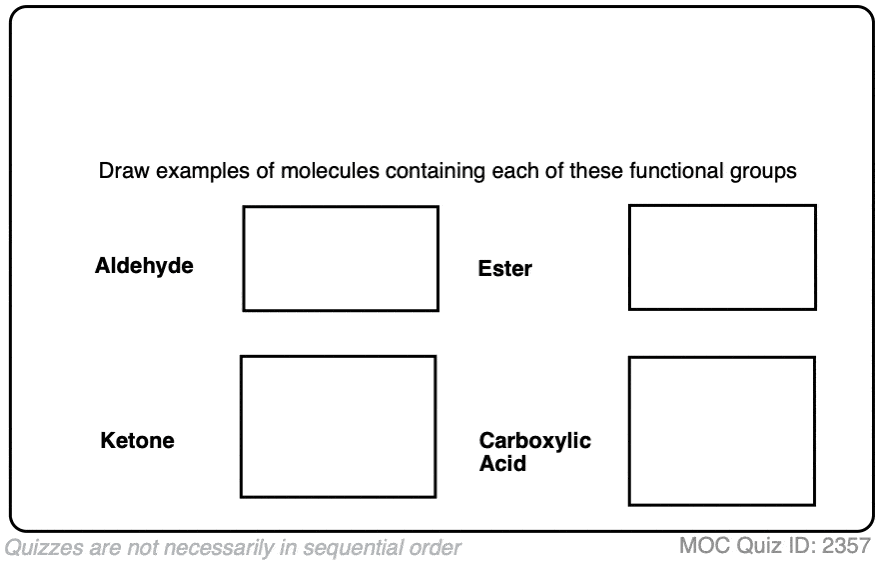 Click to Flip
Click to Flip
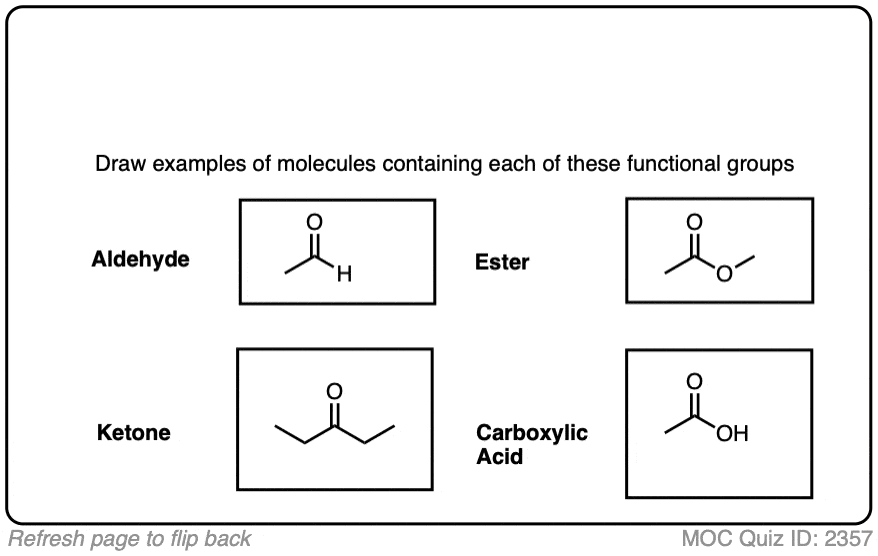
Draw in the functional group for these prominent molecules.
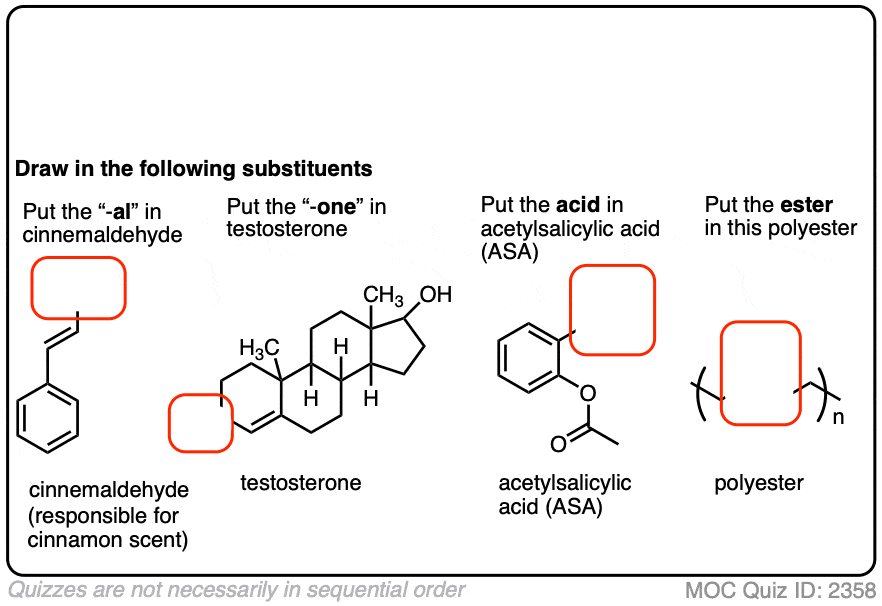 Click to Flip
Click to Flip
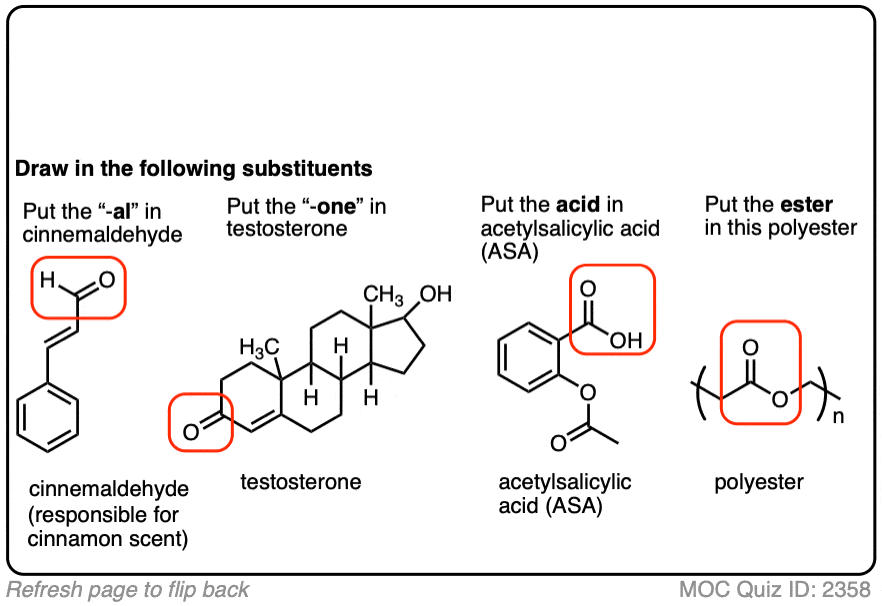
5. Amides, Acid Halides, Anhydrides, Nitriles
There are actually quite a few important functional groups containing carbonyls. These functional groups are all considered to be derived from carboxylic acids, as they can be obtained through replacement of OH with various groups. (Nitriles might not appear to be related to carboxylic acids at first glance, but they can actually be converted into amides through dehydration.)
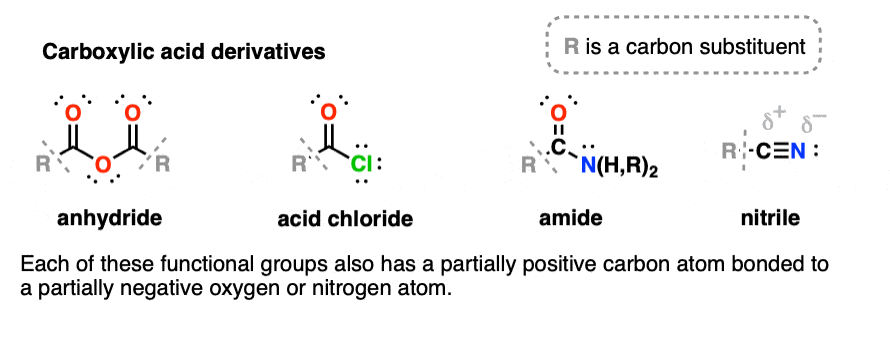
Amides contain a carbonyl carbon attached to an amino group.
- Amino acids linked together through formation of an amide are known as peptides.
- Amides containing N-H bonds can participate in hydrogen bonding.
Acid Halides have -OH replaced with F, Cl, Br, or I.
Anhydrides contain an oxygen flanked by two carbonyls. Distinct from esters.
- Anhydrides can be formed from two equivalents of a carboxylic acid with accompanying loss of H2O, hence the name.
Nitriles don’t look like carboxylic acid derivatives at first, but they can be formed via the dehydration of amides.
- Acetonitrile is a common solvent.
- “Nitrile gloves” are made from nitrile rubber, a co-polymer of butadiene and acrylonitrile.
- The -CN substituent is sometimes referred to as a cyanide.
- HCN, hydrogen cyanide, is a highly toxic gas. The cyanide ion (-)CN, is often encountered in introductory courses (on paper, not in the lab!) and undergoes reactions with alkyl halides.
Draw in examples of an amide, acid halide, anhydride, and nitrile.
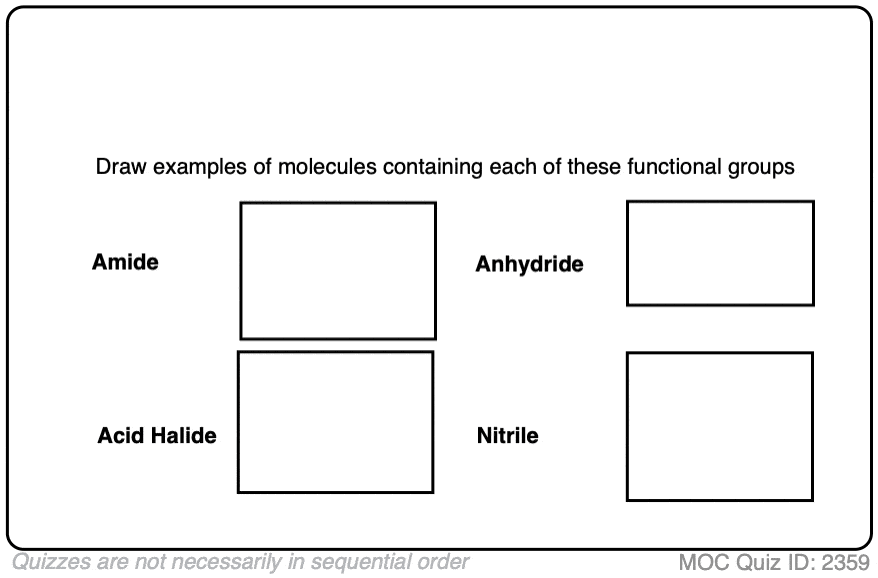 Click to Flip
Click to Flip
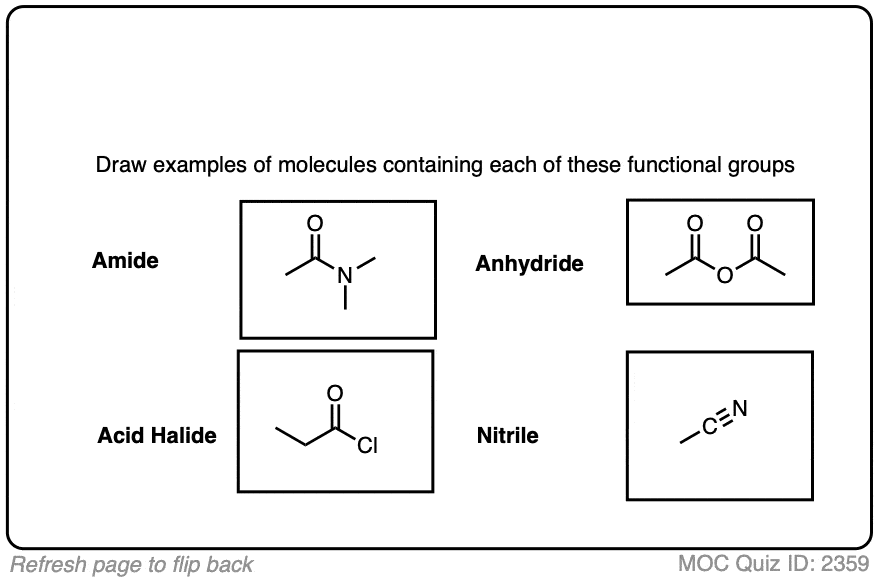
Fill in the functional groups of these famous molecules.
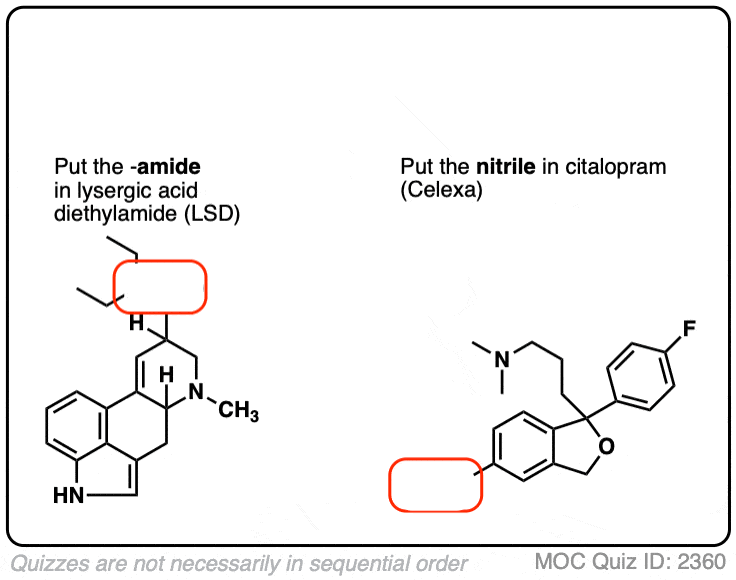 Click to Flip
Click to Flip
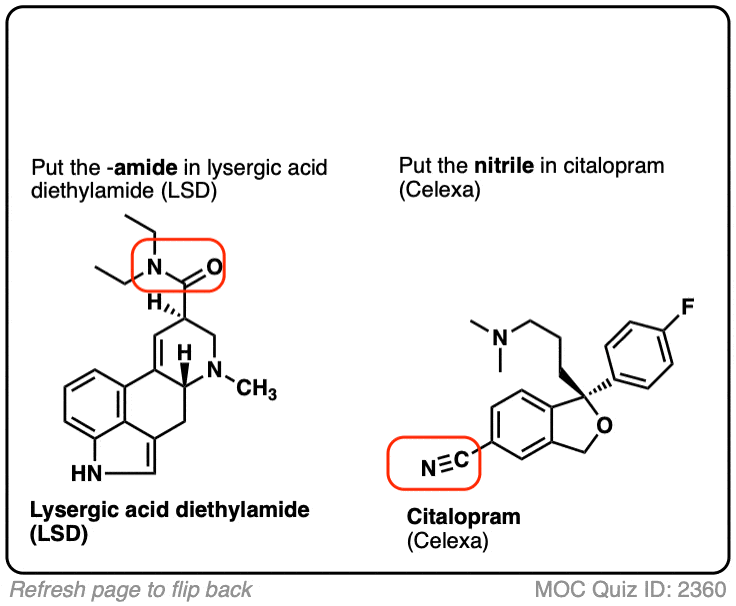
6. Miscellaneous: Epoxides, Thioethers, Nitro, Imine, Azide
No common thread here; just a few more prominent functional groups worth knowing.

Technically, Epoxides are ethers, but since they participate in a number of reactions that ethers generally don’t , they deserve their own category.
Thioethers (sulfides) are the sulfur equivalents of ethers. Dimethyl sulfide is the most commonly encountered example.
Nitro groups are strongly electron-withdrawing. Nitromethane, a solvent, is the simplest example of a nitroalkane.
Imines are the nitrogen-containing equivalents of aldehydes and ketones.
Azides pop up from time to time. The “A” in the anti-HIV drug AZT stands for azido.
Draw in the functional groups in these molecules.
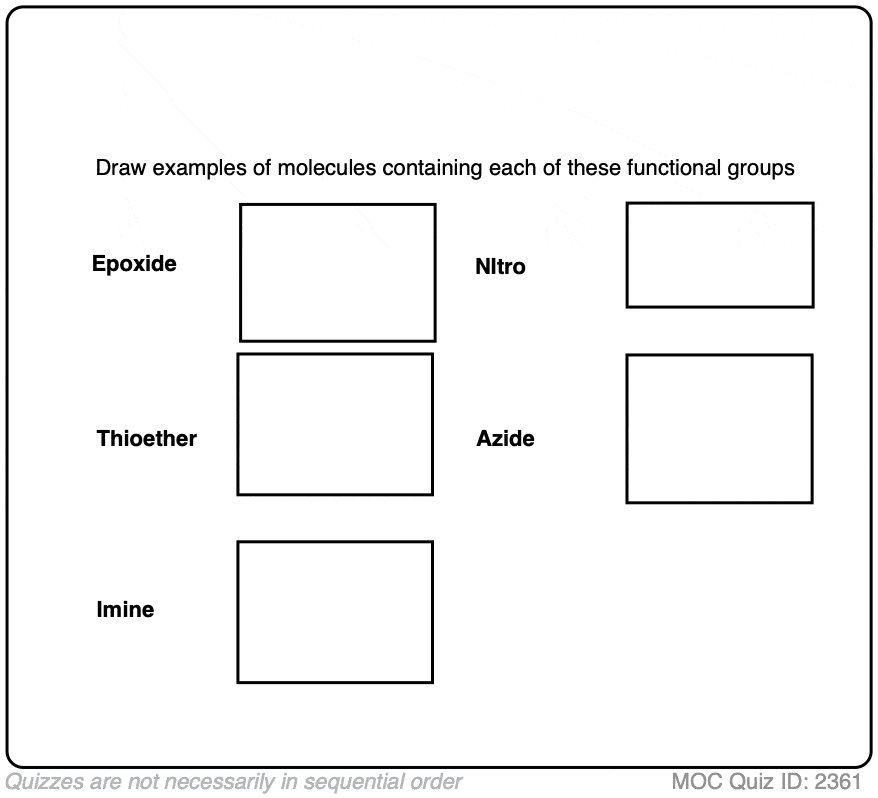 Click to Flip
Click to Flip
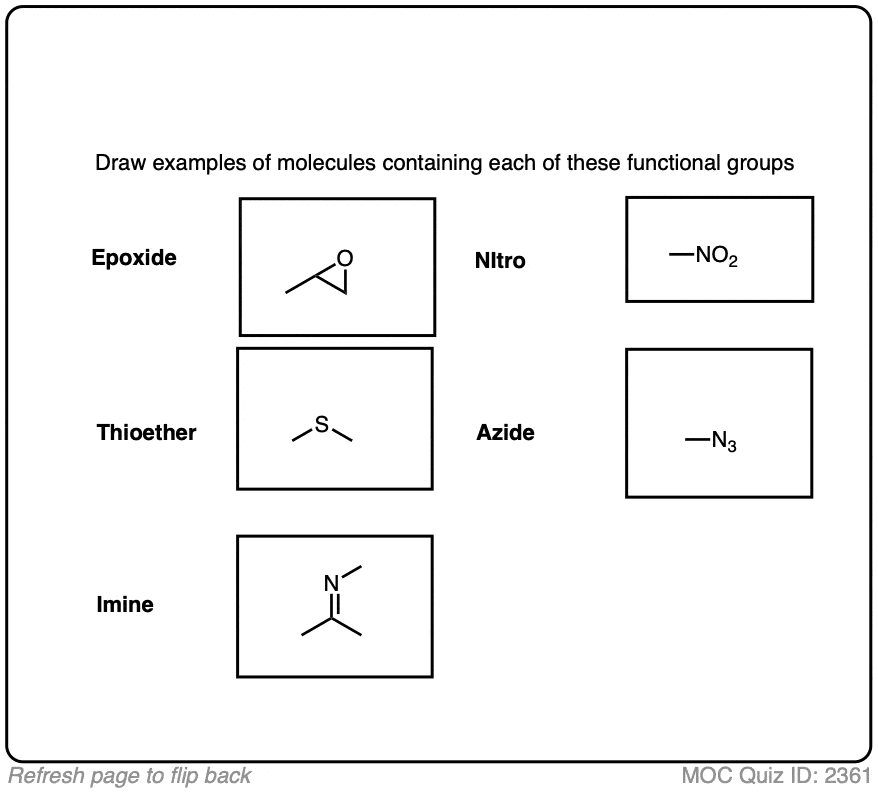
7. That’s Probably Enough For Now
Of course there are more functional groups that you will encounter, but this list should be sufficient for most students in an Org 1 course. Past a certain point, the law of diminishing returns starts to apply.
The sooner you try to get beyond knowing the name of a functional group and start to apply concepts like electronegativity and resonance, the more “alive” each of these functional groups will seem to you.
Notes
Related Articles
- Primary, Secondary, Tertiary, Quaternary In Organic Chemistry
- How to apply electronegativity and resonance to understand reactivity
- How To Find The Best Resonance Structure By Applying Electronegativity
- Don’t Be Futyl, Learn The Butyls
- Alcohols Nomenclature Properties
- The Amide Functional Group: Properties, Synthesis, and Nomenclature
Quiz Yourself!
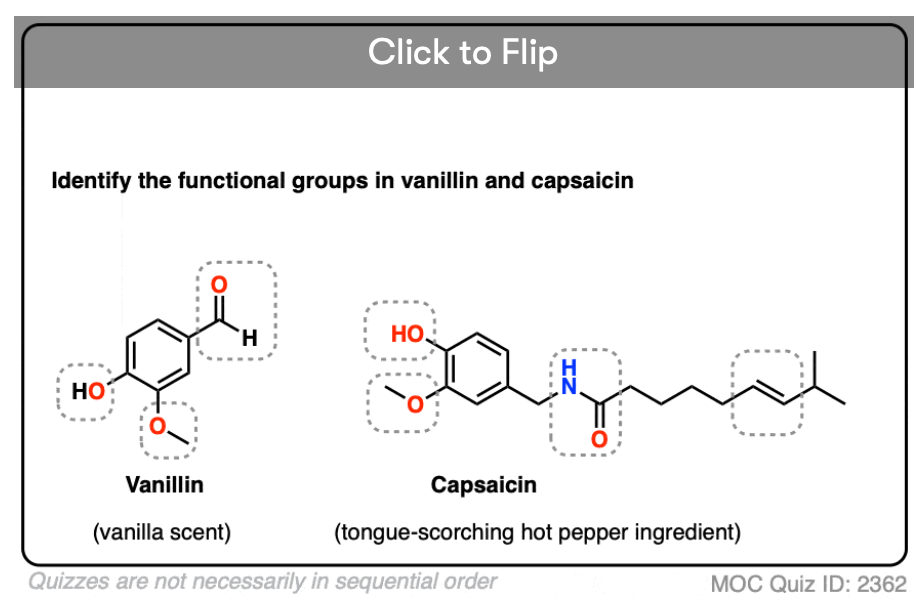
Become a MOC member to see the clickable quiz with answers on the back.
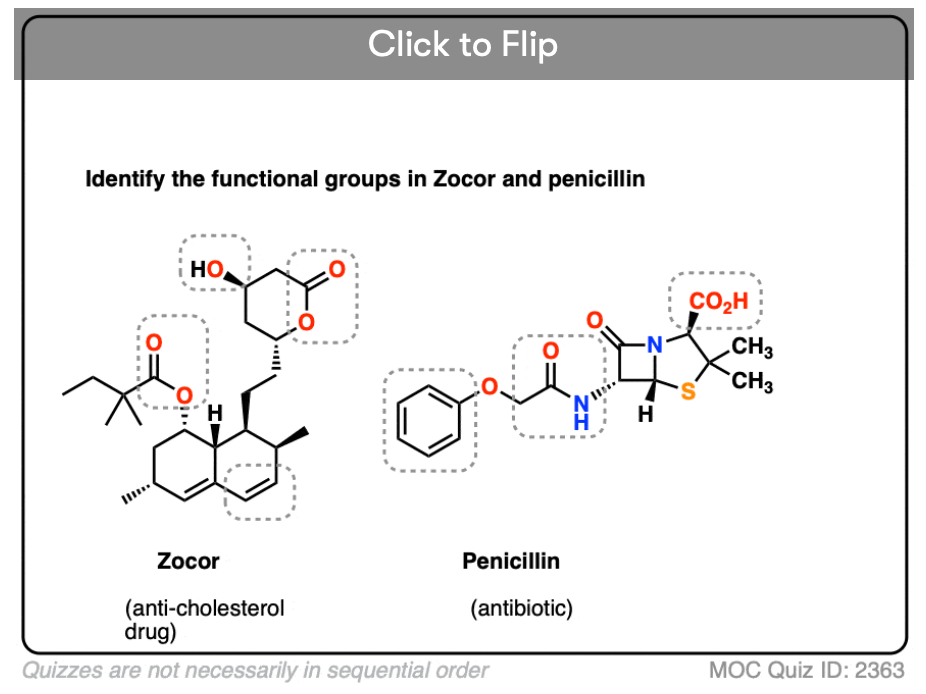
Become a MOC member to see the clickable quiz with answers on the back.
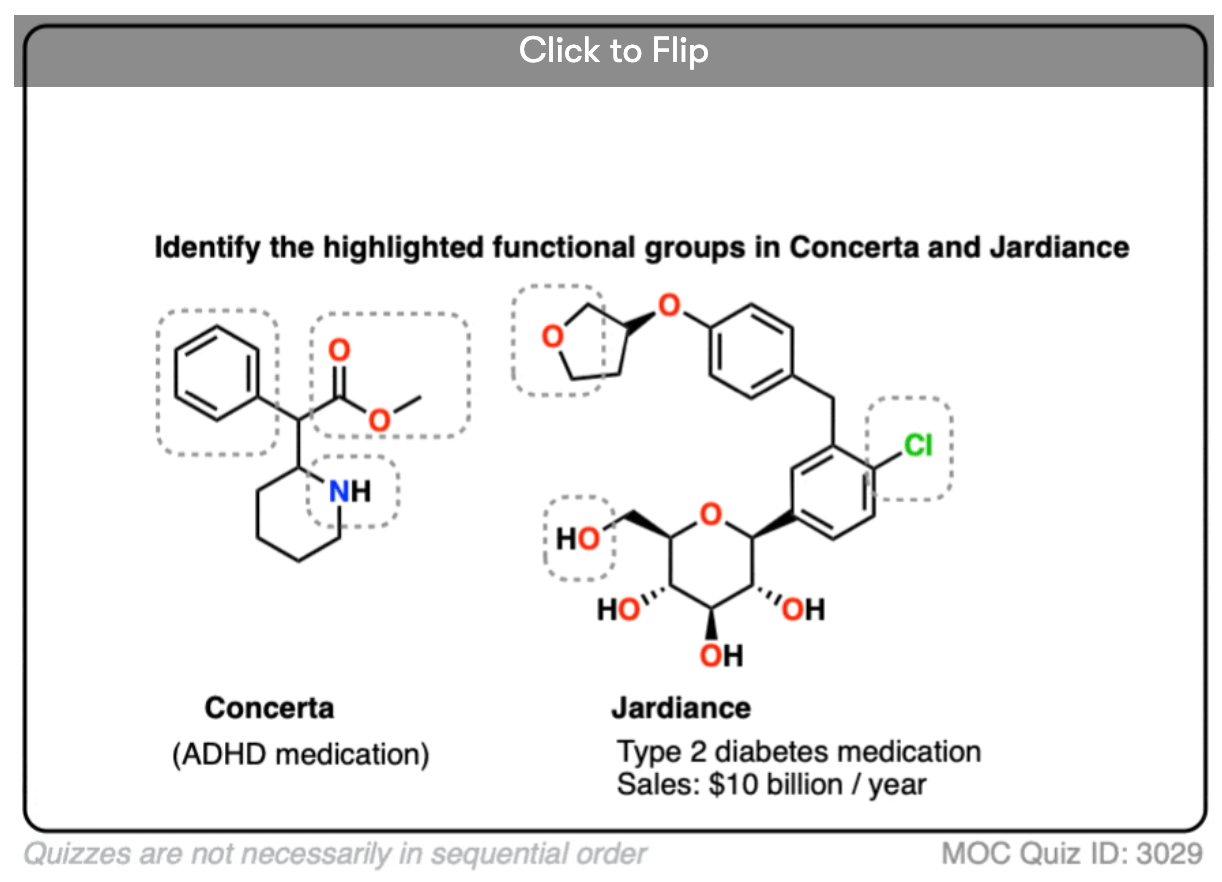
Become a MOC member to see the clickable quiz with answers on the back.
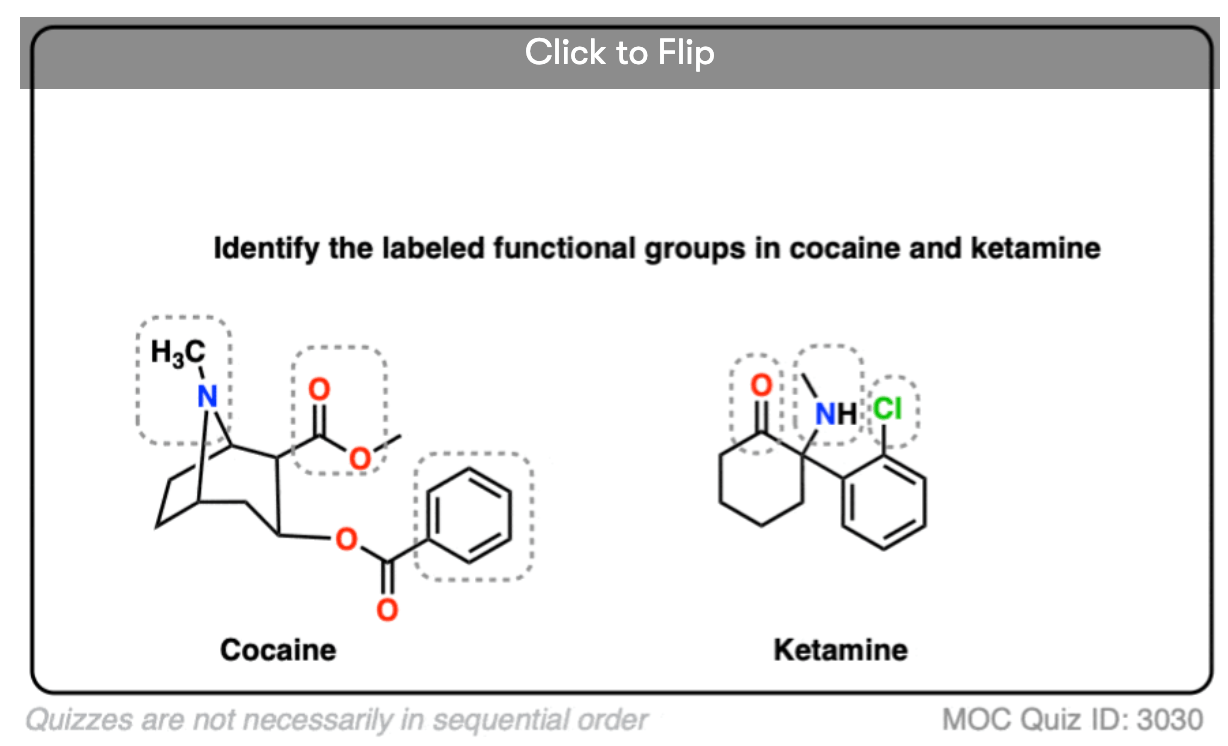
Become a MOC member to see the clickable quiz with answers on the back.
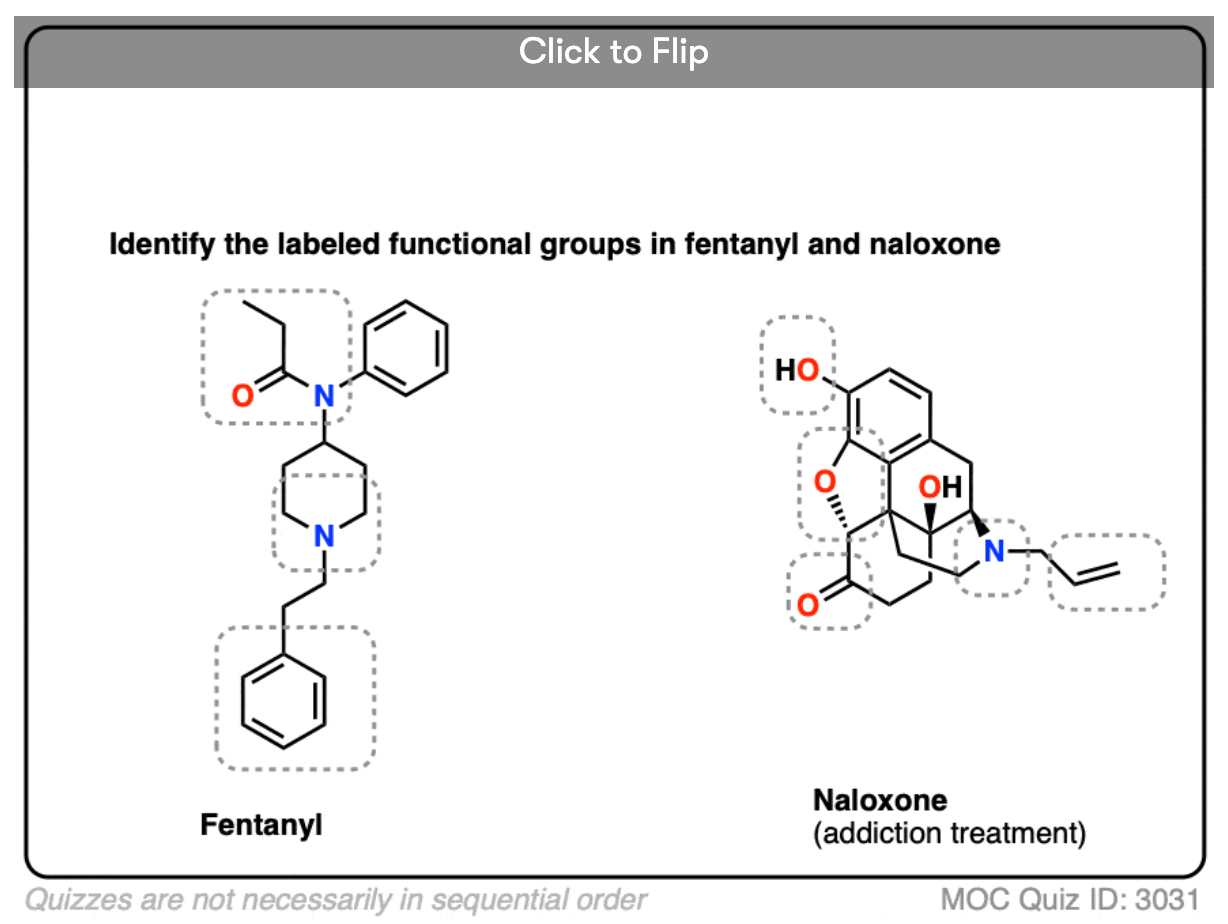
Become a MOC member to see the clickable quiz with answers on the back.
(Advanced) References and Further Reading
- Relating Functional Groups to the Periodic Table
Jef Struyf
Journal of Chemical Education 2009 86 (2), 190
DOI: 10.1021/ed086p190 - Learning the Functional Groups: Keys to Success
Shannon Byrd and David P. Hildreth
Journal of Chemical Education 2001 78 (10), 1355
DOI: 10.1021/ed078p1355
00 General Chemistry Review
01 Bonding, Structure, and Resonance
- How Do We Know Methane (CH4) Is Tetrahedral?
- Hybrid Orbitals and Hybridization
- How To Determine Hybridization: A Shortcut
- Orbital Hybridization And Bond Strengths
- Sigma bonds come in six varieties: Pi bonds come in one
- A Key Skill: How to Calculate Formal Charge
- The Four Intermolecular Forces and How They Affect Boiling Points
- 3 Trends That Affect Boiling Points
- How To Use Electronegativity To Determine Electron Density (and why NOT to trust formal charge)
- Introduction to Resonance
- How To Use Curved Arrows To Interchange Resonance Forms
- Evaluating Resonance Forms (1) - The Rule of Least Charges
- How To Find The Best Resonance Structure By Applying Electronegativity
- Evaluating Resonance Structures With Negative Charges
- Evaluating Resonance Structures With Positive Charge
- Exploring Resonance: Pi-Donation
- Exploring Resonance: Pi-acceptors
- In Summary: Evaluating Resonance Structures
- Drawing Resonance Structures: 3 Common Mistakes To Avoid
- How to apply electronegativity and resonance to understand reactivity
- Bond Hybridization Practice
- Structure and Bonding Practice Quizzes
- Resonance Structures Practice
02 Acid Base Reactions
- Introduction to Acid-Base Reactions
- Acid Base Reactions In Organic Chemistry
- The Stronger The Acid, The Weaker The Conjugate Base
- Walkthrough of Acid-Base Reactions (3) - Acidity Trends
- Five Key Factors That Influence Acidity
- Acid-Base Reactions: Introducing Ka and pKa
- How to Use a pKa Table
- The pKa Table Is Your Friend
- A Handy Rule of Thumb for Acid-Base Reactions
- Acid Base Reactions Are Fast
- pKa Values Span 60 Orders Of Magnitude
- How Protonation and Deprotonation Affect Reactivity
- Acid Base Practice Problems
03 Alkanes and Nomenclature
- Meet the (Most Important) Functional Groups
- Condensed Formulas: Deciphering What the Brackets Mean
- Hidden Hydrogens, Hidden Lone Pairs, Hidden Counterions
- Don't Be Futyl, Learn The Butyls
- Primary, Secondary, Tertiary, Quaternary In Organic Chemistry
- Branching, and Its Affect On Melting and Boiling Points
- The Many, Many Ways of Drawing Butane
- Wedge And Dash Convention For Tetrahedral Carbon
- Common Mistakes in Organic Chemistry: Pentavalent Carbon
- Table of Functional Group Priorities for Nomenclature
- Summary Sheet - Alkane Nomenclature
- Organic Chemistry IUPAC Nomenclature Demystified With A Simple Puzzle Piece Approach
- Boiling Point Quizzes
- Organic Chemistry Nomenclature Quizzes
04 Conformations and Cycloalkanes
- Staggered vs Eclipsed Conformations of Ethane
- Conformational Isomers of Propane
- Newman Projection of Butane (and Gauche Conformation)
- Introduction to Cycloalkanes
- Geometric Isomers In Small Rings: Cis And Trans Cycloalkanes
- Calculation of Ring Strain In Cycloalkanes
- Cycloalkanes - Ring Strain In Cyclopropane And Cyclobutane
- Cyclohexane Conformations
- Cyclohexane Chair Conformation: An Aerial Tour
- How To Draw The Cyclohexane Chair Conformation
- The Cyclohexane Chair Flip
- The Cyclohexane Chair Flip - Energy Diagram
- Substituted Cyclohexanes - Axial vs Equatorial
- Ranking The Bulkiness Of Substituents On Cyclohexanes: "A-Values"
- Cyclohexane Chair Conformation Stability: Which One Is Lower Energy?
- Fused Rings - Cis-Decalin and Trans-Decalin
- Naming Bicyclic Compounds - Fused, Bridged, and Spiro
- Bredt's Rule (And Summary of Cycloalkanes)
- Newman Projection Practice
- Cycloalkanes Practice Problems
05 A Primer On Organic Reactions
- The Most Important Question To Ask When Learning a New Reaction
- Curved Arrows (for reactions)
- Nucleophiles and Electrophiles
- The Three Classes of Nucleophiles
- Nucleophilicity vs. Basicity
- What Makes A Good Nucleophile?
- What Makes A Good Leaving Group?
- 3 Factors That Stabilize Carbocations
- Equilibrium and Energy Relationships
- 7 Factors that stabilize negative charge in organic chemistry
- 7 Factors That Stabilize Positive Charge in Organic Chemistry
- What's a Transition State?
- Hammond's Postulate
- Learning Organic Chemistry Reactions: A Checklist (PDF)
- Introduction to Oxidative Cleavage Reactions
06 Free Radical Reactions
- Free Radical Reactions
- 3 Factors That Stabilize Free Radicals
- Bond Strengths And Radical Stability
- Free Radical Initiation: Why Is "Light" Or "Heat" Required?
- Initiation, Propagation, Termination
- Monochlorination Products Of Propane, Pentane, And Other Alkanes
- Selectivity In Free Radical Reactions
- Selectivity in Free Radical Reactions: Bromination vs. Chlorination
- Halogenation At Tiffany's
- Allylic Bromination
- Bonus Topic: Allylic Rearrangements
- In Summary: Free Radicals
- Synthesis (2) - Reactions of Alkanes
- Free Radicals Practice Quizzes
07 Stereochemistry and Chirality
- Types of Isomers: Constitutional Isomers, Stereoisomers, Enantiomers, and Diastereomers
- How To Draw The Enantiomer Of A Chiral Molecule
- How To Draw A Bond Rotation
- Introduction to Assigning (R) and (S): The Cahn-Ingold-Prelog Rules
- Assigning Cahn-Ingold-Prelog (CIP) Priorities (2) - The Method of Dots
- Enantiomers vs Diastereomers vs The Same? Two Methods For Solving Problems
- Assigning R/S To Newman Projections (And Converting Newman To Line Diagrams)
- How To Determine R and S Configurations On A Fischer Projection
- The Meso Trap
- Optical Rotation, Optical Activity, and Specific Rotation
- Optical Purity and Enantiomeric Excess
- What's a Racemic Mixture?
- Chiral Allenes And Chiral Axes
- Stereochemistry Practice Problems and Quizzes
08 Substitution Reactions
- Nucleophilic Substitution Reactions - Introduction
- Two Types of Nucleophilic Substitution Reactions
- The SN2 Mechanism
- Why the SN2 Reaction Is Powerful
- The SN1 Mechanism
- The Conjugate Acid Is A Better Leaving Group
- Comparing the SN1 and SN2 Reactions
- Polar Protic? Polar Aprotic? Nonpolar? All About Solvents
- Steric Hindrance is Like a Fat Goalie
- Common Blind Spot: Intramolecular Reactions
- Substitution Practice - SN1
- Substitution Practice - SN2
09 Elimination Reactions
- Elimination Reactions (1): Introduction And The Key Pattern
- Elimination Reactions (2): The Zaitsev Rule
- Elimination Reactions Are Favored By Heat
- Two Elimination Reaction Patterns
- The E1 Reaction
- The E2 Mechanism
- E1 vs E2: Comparing the E1 and E2 Reactions
- Antiperiplanar Relationships: The E2 Reaction and Cyclohexane Rings
- Bulky Bases in Elimination Reactions
- Comparing the E1 vs SN1 Reactions
- Elimination (E1) Reactions With Rearrangements
- E1cB - Elimination (Unimolecular) Conjugate Base
- Elimination (E1) Practice Problems And Solutions
- Elimination (E2) Practice Problems and Solutions
10 Rearrangements
11 SN1/SN2/E1/E2 Decision
- Identifying Where Substitution and Elimination Reactions Happen
- Deciding SN1/SN2/E1/E2 (1) - The Substrate
- Deciding SN1/SN2/E1/E2 (2) - The Nucleophile/Base
- SN1 vs E1 and SN2 vs E2 : The Temperature
- Deciding SN1/SN2/E1/E2 - The Solvent
- Wrapup: The Key Factors For Determining SN1/SN2/E1/E2
- Alkyl Halide Reaction Map And Summary
- SN1 SN2 E1 E2 Practice Problems
12 Alkene Reactions
- E and Z Notation For Alkenes (+ Cis/Trans)
- Alkene Stability
- Alkene Addition Reactions: "Regioselectivity" and "Stereoselectivity" (Syn/Anti)
- Stereoselective and Stereospecific Reactions
- Hydrohalogenation of Alkenes and Markovnikov's Rule
- Hydration of Alkenes With Aqueous Acid
- Rearrangements in Alkene Addition Reactions
- Halogenation of Alkenes and Halohydrin Formation
- Oxymercuration Demercuration of Alkenes
- Hydroboration Oxidation of Alkenes
- m-CPBA (meta-chloroperoxybenzoic acid)
- OsO4 (Osmium Tetroxide) for Dihydroxylation of Alkenes
- Palladium on Carbon (Pd/C) for Catalytic Hydrogenation of Alkenes
- Cyclopropanation of Alkenes
- A Fourth Alkene Addition Pattern - Free Radical Addition
- Alkene Reactions: Ozonolysis
- Summary: Three Key Families Of Alkene Reaction Mechanisms
- Synthesis (4) - Alkene Reaction Map, Including Alkyl Halide Reactions
- Alkene Reactions Practice Problems
13 Alkyne Reactions
- Acetylides from Alkynes, And Substitution Reactions of Acetylides
- Partial Reduction of Alkynes With Lindlar's Catalyst
- Partial Reduction of Alkynes With Na/NH3 To Obtain Trans Alkenes
- Alkyne Hydroboration With "R2BH"
- Hydration and Oxymercuration of Alkynes
- Hydrohalogenation of Alkynes
- Alkyne Halogenation: Bromination and Chlorination of Alkynes
- Oxidation of Alkynes With O3 and KMnO4
- Alkenes To Alkynes Via Halogenation And Elimination Reactions
- Alkynes Are A Blank Canvas
- Synthesis (5) - Reactions of Alkynes
- Alkyne Reactions Practice Problems With Answers
14 Alcohols, Epoxides and Ethers
- Alcohols - Nomenclature and Properties
- Alcohols Can Act As Acids Or Bases (And Why It Matters)
- Alcohols - Acidity and Basicity
- The Williamson Ether Synthesis
- Ethers From Alkenes, Tertiary Alkyl Halides and Alkoxymercuration
- Alcohols To Ethers via Acid Catalysis
- Cleavage Of Ethers With Acid
- Epoxides - The Outlier Of The Ether Family
- Opening of Epoxides With Acid
- Epoxide Ring Opening With Base
- Making Alkyl Halides From Alcohols
- Tosylates And Mesylates
- PBr3 and SOCl2
- Elimination Reactions of Alcohols
- Elimination of Alcohols To Alkenes With POCl3
- Alcohol Oxidation: "Strong" and "Weak" Oxidants
- Demystifying The Mechanisms of Alcohol Oxidations
- Protecting Groups For Alcohols
- Thiols And Thioethers
- Calculating the oxidation state of a carbon
- Oxidation and Reduction in Organic Chemistry
- Oxidation Ladders
- SOCl2 Mechanism For Alcohols To Alkyl Halides: SN2 versus SNi
- Alcohol Reactions Roadmap (PDF)
- Alcohol Reaction Practice Problems
- Epoxide Reaction Quizzes
- Oxidation and Reduction Practice Quizzes
15 Organometallics
- What's An Organometallic?
- Formation of Grignard and Organolithium Reagents
- Organometallics Are Strong Bases
- Reactions of Grignard Reagents
- Protecting Groups In Grignard Reactions
- Synthesis Problems Involving Grignard Reagents
- Grignard Reactions And Synthesis (2)
- Organocuprates (Gilman Reagents): How They're Made
- Gilman Reagents (Organocuprates): What They're Used For
- The Heck, Suzuki, and Olefin Metathesis Reactions (And Why They Don't Belong In Most Introductory Organic Chemistry Courses)
- Reaction Map: Reactions of Organometallics
- Grignard Practice Problems
16 Spectroscopy
- Degrees of Unsaturation (or IHD, Index of Hydrogen Deficiency)
- Conjugation And Color (+ How Bleach Works)
- Introduction To UV-Vis Spectroscopy
- UV-Vis Spectroscopy: Absorbance of Carbonyls
- UV-Vis Spectroscopy: Practice Questions
- Bond Vibrations, Infrared Spectroscopy, and the "Ball and Spring" Model
- Infrared Spectroscopy: A Quick Primer On Interpreting Spectra
- IR Spectroscopy: 4 Practice Problems
- 1H NMR: How Many Signals?
- Homotopic, Enantiotopic, Diastereotopic
- Diastereotopic Protons in 1H NMR Spectroscopy: Examples
- 13-C NMR - How Many Signals
- Liquid Gold: Pheromones In Doe Urine
- Natural Product Isolation (1) - Extraction
- Natural Product Isolation (2) - Purification Techniques, An Overview
- Structure Determination Case Study: Deer Tarsal Gland Pheromone
17 Dienes and MO Theory
- What To Expect In Organic Chemistry 2
- Are these molecules conjugated?
- Conjugation And Resonance In Organic Chemistry
- Bonding And Antibonding Pi Orbitals
- Molecular Orbitals of The Allyl Cation, Allyl Radical, and Allyl Anion
- Pi Molecular Orbitals of Butadiene
- Reactions of Dienes: 1,2 and 1,4 Addition
- Thermodynamic and Kinetic Products
- More On 1,2 and 1,4 Additions To Dienes
- s-cis and s-trans
- The Diels-Alder Reaction
- Cyclic Dienes and Dienophiles in the Diels-Alder Reaction
- Stereochemistry of the Diels-Alder Reaction
- Exo vs Endo Products In The Diels Alder: How To Tell Them Apart
- HOMO and LUMO In the Diels Alder Reaction
- Why Are Endo vs Exo Products Favored in the Diels-Alder Reaction?
- Diels-Alder Reaction: Kinetic and Thermodynamic Control
- The Retro Diels-Alder Reaction
- The Intramolecular Diels Alder Reaction
- Regiochemistry In The Diels-Alder Reaction
- The Cope and Claisen Rearrangements
- Electrocyclic Reactions
- Electrocyclic Ring Opening And Closure (2) - Six (or Eight) Pi Electrons
- Diels Alder Practice Problems
- Molecular Orbital Theory Practice
18 Aromaticity
- Introduction To Aromaticity
- Rules For Aromaticity
- Huckel's Rule: What Does 4n+2 Mean?
- Aromatic, Non-Aromatic, or Antiaromatic? Some Practice Problems
- Antiaromatic Compounds and Antiaromaticity
- The Pi Molecular Orbitals of Benzene
- The Pi Molecular Orbitals of Cyclobutadiene
- Frost Circles
- Aromaticity Practice Quizzes
19 Reactions of Aromatic Molecules
- Electrophilic Aromatic Substitution: Introduction
- Activating and Deactivating Groups In Electrophilic Aromatic Substitution
- Electrophilic Aromatic Substitution - The Mechanism
- Ortho-, Para- and Meta- Directors in Electrophilic Aromatic Substitution
- Understanding Ortho, Para, and Meta Directors
- Why are halogens ortho- para- directors?
- Disubstituted Benzenes: The Strongest Electron-Donor "Wins"
- Electrophilic Aromatic Substitutions (1) - Halogenation of Benzene
- Electrophilic Aromatic Substitutions (2) - Nitration and Sulfonation
- EAS Reactions (3) - Friedel-Crafts Acylation and Friedel-Crafts Alkylation
- Intramolecular Friedel-Crafts Reactions
- Nucleophilic Aromatic Substitution (NAS)
- Nucleophilic Aromatic Substitution (2) - The Benzyne Mechanism
- Reactions on the "Benzylic" Carbon: Bromination And Oxidation
- The Wolff-Kishner, Clemmensen, And Other Carbonyl Reductions
- More Reactions on the Aromatic Sidechain: Reduction of Nitro Groups and the Baeyer Villiger
- Aromatic Synthesis (1) - "Order Of Operations"
- Synthesis of Benzene Derivatives (2) - Polarity Reversal
- Aromatic Synthesis (3) - Sulfonyl Blocking Groups
- Birch Reduction
- Synthesis (7): Reaction Map of Benzene and Related Aromatic Compounds
- Aromatic Reactions and Synthesis Practice
- Electrophilic Aromatic Substitution Practice Problems
20 Aldehydes and Ketones
- What's The Alpha Carbon In Carbonyl Compounds?
- Nucleophilic Addition To Carbonyls
- Aldehydes and Ketones: 14 Reactions With The Same Mechanism
- Sodium Borohydride (NaBH4) Reduction of Aldehydes and Ketones
- Grignard Reagents For Addition To Aldehydes and Ketones
- Wittig Reaction
- Hydrates, Hemiacetals, and Acetals
- Imines - Properties, Formation, Reactions, and Mechanisms
- All About Enamines
- Breaking Down Carbonyl Reaction Mechanisms: Reactions of Anionic Nucleophiles (Part 2)
- Aldehydes Ketones Reaction Practice
21 Carboxylic Acid Derivatives
- Nucleophilic Acyl Substitution (With Negatively Charged Nucleophiles)
- Addition-Elimination Mechanisms With Neutral Nucleophiles (Including Acid Catalysis)
- Basic Hydrolysis of Esters - Saponification
- Transesterification
- Proton Transfer
- Fischer Esterification - Carboxylic Acid to Ester Under Acidic Conditions
- Lithium Aluminum Hydride (LiAlH4) For Reduction of Carboxylic Acid Derivatives
- LiAlH[Ot-Bu]3 For The Reduction of Acid Halides To Aldehydes
- Di-isobutyl Aluminum Hydride (DIBAL) For The Partial Reduction of Esters and Nitriles
- Amide Hydrolysis
- Thionyl Chloride (SOCl2) And Conversion of Carboxylic Acids to Acid Halides
- Diazomethane (CH2N2)
- Carbonyl Chemistry: Learn Six Mechanisms For the Price Of One
- Making Music With Mechanisms (PADPED)
- Carboxylic Acid Derivatives Practice Questions
22 Enols and Enolates
- Keto-Enol Tautomerism
- Enolates - Formation, Stability, and Simple Reactions
- Kinetic Versus Thermodynamic Enolates
- Aldol Addition and Condensation Reactions
- Reactions of Enols - Acid-Catalyzed Aldol, Halogenation, and Mannich Reactions
- Claisen Condensation and Dieckmann Condensation
- Decarboxylation
- The Malonic Ester and Acetoacetic Ester Synthesis
- The Michael Addition Reaction and Conjugate Addition
- The Robinson Annulation
- Haloform Reaction
- The Hell–Volhard–Zelinsky Reaction
- Enols and Enolates Practice Quizzes
23 Amines
- The Amide Functional Group: Properties, Synthesis, and Nomenclature
- Basicity of Amines And pKaH
- 5 Key Basicity Trends of Amines
- The Mesomeric Effect And Aromatic Amines
- Nucleophilicity of Amines
- Alkylation of Amines (Sucks!)
- Reductive Amination
- The Gabriel Synthesis
- Some Reactions of Azides
- The Hofmann Elimination
- The Hofmann and Curtius Rearrangements
- The Cope Elimination
- Protecting Groups for Amines - Carbamates
- The Strecker Synthesis of Amino Acids
- Introduction to Peptide Synthesis
- Reactions of Diazonium Salts: Sandmeyer and Related Reactions
- Amine Practice Questions
24 Carbohydrates
- D and L Notation For Sugars
- Pyranoses and Furanoses: Ring-Chain Tautomerism In Sugars
- What is Mutarotation?
- Reducing Sugars
- The Big Damn Post Of Carbohydrate-Related Chemistry Definitions
- The Haworth Projection
- Converting a Fischer Projection To A Haworth (And Vice Versa)
- Reactions of Sugars: Glycosylation and Protection
- The Ruff Degradation and Kiliani-Fischer Synthesis
- Isoelectric Points of Amino Acids (and How To Calculate Them)
- Carbohydrates Practice
- Amino Acid Quizzes
25 Fun and Miscellaneous
- A Gallery of Some Interesting Molecules From Nature
- Screw Organic Chemistry, I'm Just Going To Write About Cats
- On Cats, Part 1: Conformations and Configurations
- On Cats, Part 2: Cat Line Diagrams
- On Cats, Part 4: Enantiocats
- On Cats, Part 6: Stereocenters
- Organic Chemistry Is Shit
- The Organic Chemistry Behind "The Pill"
- Maybe they should call them, "Formal Wins" ?
- Why Do Organic Chemists Use Kilocalories?
- The Principle of Least Effort
- Organic Chemistry GIFS - Resonance Forms
- Reproducibility In Organic Chemistry
- What Holds The Nucleus Together?
- How Reactions Are Like Music
- Organic Chemistry and the New MCAT
26 Organic Chemistry Tips and Tricks
- Common Mistakes: Formal Charges Can Mislead
- Partial Charges Give Clues About Electron Flow
- Draw The Ugly Version First
- Organic Chemistry Study Tips: Learn the Trends
- The 8 Types of Arrows In Organic Chemistry, Explained
- Top 10 Skills To Master Before An Organic Chemistry 2 Final
- Common Mistakes with Carbonyls: Carboxylic Acids... Are Acids!
- Planning Organic Synthesis With "Reaction Maps"
- Alkene Addition Pattern #1: The "Carbocation Pathway"
- Alkene Addition Pattern #2: The "Three-Membered Ring" Pathway
- Alkene Addition Pattern #3: The "Concerted" Pathway
- Number Your Carbons!
- The 4 Major Classes of Reactions in Org 1
- How (and why) electrons flow
- Grossman's Rule
- Three Exam Tips
- A 3-Step Method For Thinking Through Synthesis Problems
- Putting It Together
- Putting Diels-Alder Products in Perspective
- The Ups and Downs of Cyclohexanes
- The Most Annoying Exceptions in Org 1 (Part 1)
- The Most Annoying Exceptions in Org 1 (Part 2)
- The Marriage May Be Bad, But the Divorce Still Costs Money
- 9 Nomenclature Conventions To Know
- Nucleophile attacks Electrophile
27 Case Studies of Successful O-Chem Students
- Success Stories: How Corina Got The The "Hard" Professor - And Got An A+ Anyway
- How Helena Aced Organic Chemistry
- From a "Drop" To B+ in Org 2 – How A Hard Working Student Turned It Around
- How Serge Aced Organic Chemistry
- Success Stories: How Zach Aced Organic Chemistry 1
- Success Stories: How Kari Went From C– to B+
- How Esther Bounced Back From a "C" To Get A's In Organic Chemistry 1 And 2
- How Tyrell Got The Highest Grade In Her Organic Chemistry Course
- This Is Why Students Use Flashcards
- Success Stories: How Stu Aced Organic Chemistry
- How John Pulled Up His Organic Chemistry Exam Grades
- Success Stories: How Nathan Aced Organic Chemistry (Without It Taking Over His Life)
- How Chris Aced Org 1 and Org 2
- Interview: How Jay Got an A+ In Organic Chemistry
- How to Do Well in Organic Chemistry: One Student's Advice
- "America's Top TA" Shares His Secrets For Teaching O-Chem
- "Organic Chemistry Is Like..." - A Few Metaphors
- How To Do Well In Organic Chemistry: Advice From A Tutor
- Guest post: "I went from being afraid of tests to actually looking forward to them".
Thank you so much. But I want these functional groups in priority order, where can I get?
There’s an article on functional group priority:
https://www.masterorganicchemistry.com/2011/02/14/table-of-functional-group-priorities-for-nomenclature/
Dear Master Organic Chemistry Team,
I hope this message finds you well. As a dedicated JEE aspirant navigating the complexities of organic chemistry, I wanted to take a moment to express my heartfelt gratitude for the invaluable resources you provide on your website. Your clear explanations, innovative approach to problem-solving, and engaging content have significantly enhanced my understanding of the subject.
The structured lessons and practical tips you offer not only demystify challenging concepts but also foster a genuine interest in organic chemistry. I have found your guides particularly helpful in my preparation, making the subject more approachable and enjoyable.
Thank you for your commitment to education and for the positive impact you have on students like me. I truly appreciate your work and look forward to continuing to learn from your insights as I strive to excel in my studies.
Warm regards,
Anuj Kshirsagar
Thank you. I am very glad you find the website useful!
It is very helpful
Thank you so much
I got what I wanted
Greetings from nigeria
Hi James, Thank you. Your site is extremely helpful as I am not a science student and need to learn chemistry. I tried to access the quiz (http://memorize.com/organic-chemistry-functional-groups/orgohacks) but it won’t load. Is the link still valid? Thanks
Memorize.com is dead, unfortunately. I should take down that link.
This helped a lot! Merci beaucoup
Hi James,
I am having a tough time these days justifying calling a hydroxyl group and alcohol group. Has this always been predominate? I was not trained this way and I can’t imagine calling something like an oxime, an alcohol.
— Kyle
Kyle – that’s a good point. I should change these figures to remove this ambiguity and avoid any confusion. Thank you for commenting.
Thanks for this 😊
Glad you found it helpful!
5 year late comment but still may matter for context, thiols are perhaps more significant in Biochemistry, see the functional group of Cystine, a particularly important amino acid.
There is absolutely no point in putting a list of names associated with molecular configuration unless you give a description of why a particular functional group is important in chemistry. One needs real scientific insight not just another lesson in learning a language.
Hello, I would like to know what ester would be best to make my science teacher (Paul) fall in love with me, I was thinking something fruity, Many thanks XOXOXOXOXO
I would move thiols to the second list, and move epoxides, imines, and acid chlorides to the first list. The latter two become incredibly relevant when discussing carbonyl addition/elimination reactions and enamine chemistry.
Hi, I’m a bit stuck. I need to find out the boiling points of pentanoic acid and 2-hexanone which I’ve already done, and compared both to find that pentanoic acid has the higher boiling point. I then need to give some sort of example and then justify this but i am not sure how to do so, could you please help?
Thankyou :)
hi Tanya! pentanoic acid has intermolecular H bridges, and hexanone, hasn´t. this fact accounts for the higher boiling point. greetings from argentina
Hello,
I would like to use the diagram from the following page in a coursepack for a course to be held at Fleming College in Ontario, Canada this fall:
https://www.masterorganicchemistry.com/2010/10/06/functional-groups-organic-chemistry/
Can you tell me whether I have permission to do this, or how I can obtain permission?
Many thanks,
Sara Cameron
Canadian Scholars’ Press Inc. (CSPI)
This entire website is an amazing resource for MCAT studying. I’m surprised you don’t have a book deal yet. thank you thank you thank you!
sir the article was really nice and informative but I did not get what I wanted…
my ques is
I hve a substituted benzene with OCH3, NO2 and Br attached at 1, 3, 5 position
so how will I name it?
will it be bromobenzene or nitrobenzene…
and in what order will I number the carbons acc to IUPAC?
PLEASE PLEASE REPLY ASAP..
I will be highly grateful.
Are you sure about the positions of Br and NO2 in this compound you have described. As it is a ether group, the functional group will be at the 5 position.
Its name is 3-Nitro 5-Bromo benzyl methyl ether
benzyl merhyl ether isn’t IUPAC compliant. 3 nitro 5 bromo methoxybenzene
Functional groups are named in alpha order if equivalent positions (3 or 5).
Therefore 3-bromo, 5-nitro methoxybenzene or, since anisole IS recognized, 3-bromo, 5-nitro anisole.
The name will be 3-nitro 5-bromo methoxy benzene
good, not bad.
thanks for posting this